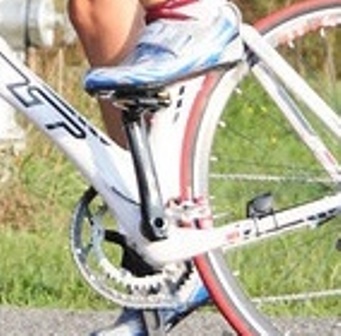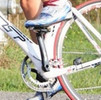Improving Cycling Pedal Force and Power Output
Posted by matt russ on 6th Aug 2015
 Propelling yourself on a bicycle is a relatively simple process. You may
either pedal with greater force, more pedal velocity, or both to achieve greater
speed. In order to accomplish this you must first transfer your body's energy
to the pedals. How much of this energy you transfer is determined by your
efficiency, and there are many ways to increase it. It is possible to be a fit
and powerful athlete, but not necessarily a fast one if you are inefficient.
Propelling yourself on a bicycle is a relatively simple process. You may
either pedal with greater force, more pedal velocity, or both to achieve greater
speed. In order to accomplish this you must first transfer your body's energy
to the pedals. How much of this energy you transfer is determined by your
efficiency, and there are many ways to increase it. It is possible to be a fit
and powerful athlete, but not necessarily a fast one if you are inefficient.
Pedal Interface
First, let's look at how your foot connects to the crank arm. The widest part of your foot should be roughly in line with the pedal spindle. Some cyclists prefer to be slightly fore or aft of this point, but generally the more efficient position is between the first and fifth metatarsal heads (two widest parts of the foot). The more solid the pedal platform is, the more force you will transfer to the crank arm. For instance, a carbon-soled shoe is very rigid and will transfer more power than a rubber-soled shoe. A loose shoe in which the foot moves about will drain power; make sure your straps are tightly secured and that you have a proper fitting shoe. If your foot is canted to the inside or the outside as you pedal, more force will be directed medially or laterally. This can be tested and corrected using shims under your cleats to level your foot, but do not attempt this without consulting a knowledgeable professional first. The rotational angle of your cleats should also match your natural biomechanics. Some pedal systems have a high degree of "float" built into them and it is not necessary to adjust for rotational angle. If you are a "pigeon-toed" or "duck-footed" cyclist, it is important to not lock your foot in a position that is contrary to how you are naturally built. This will cause compensation in your pedal stroke, wasted energy, and perhaps an overuse injury.
Pedal Force
Optimally, force should be applied perpendicular to the crank arm. Any force that is applied in a different direction does not directly work towards your speed. Most pedal force is produced from the top to bottom of the pedal stroke. An efficient cyclist will begin producing force at 1 o'clock or just over the top. If you attempt to produce force by "pulling up" on your pedals through the bottom of the pedal stroke, one leg will fight the other. By pulling you over activate the hamstring group on the upstroke which has even greater negative effect for triathletes that must run off the bike. Through the bottom of the pedal stroke you simply need to un-weight the pedal so that it can move at equal velocity to the crank arm on the upstroke. Use the hip flexors to accomplish this. They are the muscles you touch when you put your hands in your front pockets. Some energy is lost in the pedaling cycle, and some energy is used to stabilize your joints to produce force, but the objective is to direct as much energy as possible to the crank arm.
Cycling Form
An efficient cyclist works within the limits of his or her own natural biomechanics to optimally produce pedal force. What does this mean? Everyone is different and will have a slightly different pedaling style based on how they are built. Cyclists are wide-hipped, duck-footed, sway-backed, overpronators, etc. It is important to not attempt to correct something that is natural as injury can occur. Keeping this in mind, there are ways to put more power to the pedals. Make sure your heels are not moving back and forth as you pedal. A small degree of float is needed in the pedal stroke, but if the heel moves excessively towards or away from the crank arm, energy is wasted. Dropping your ankles as you pedal or pedaling with your feet (ankling) does not produce force effectively. The muscles of the lower leg play an important stability role, but the bigger muscles of the upper leg are the prime force producers. "Knees out" pedaling is another more common form issue. Your knees should track roughly within a line from the hip to the foot. If your hips "bob" in the saddle while pedaling, it is again more lost energy. The hips should be blocked and level. A straight back is a more stable platform for force production than a rounded back. A strong core enables greater force production.
There are, of course, times when you will use the muscles of your upper body to assist in force production; but if you maintain a tight grip on the handlebars you waste calories that could be going to your legs. Overall, pedaling form should be fluid and body relaxed. A relaxed body absorbs road shock and vibration, whereas a stiff body fatigues from it. Video analysis or pedal stroke analysis using a Computrainer is a great way to identify form issues and can be incorporated into the fit process.
Fit
Your bike fit must consider your comfort, aerodynamics, and power. The ratio of these ingredients will depend on the type of cycling you are doing, your biomechanics, and competitive level. A poorly fitted bicycle, however, does not allow you to produce force effectively. A seat that is too high, low, or positioned too far forward or aft will affect power. A cockpit that is too close or stretched will be uncomfortable and may cause neck and shoulder strain. A bike that is too big or small will not be nearly as effective as the proper frame size. Only when you are on the right bike, comfortable, and lined up correctly, can you really put the power to the pedals.
Taking aerodynamic drag out of the equation cycling is mainly about producing torque on the drive train. This is initiated at the pedal spindle. All of these variables affect how much torque you will produce. Training or adjusting your pedal stroke for improved efficiency is "free speed." You don't necessarily have to work harder, just more effectively.


